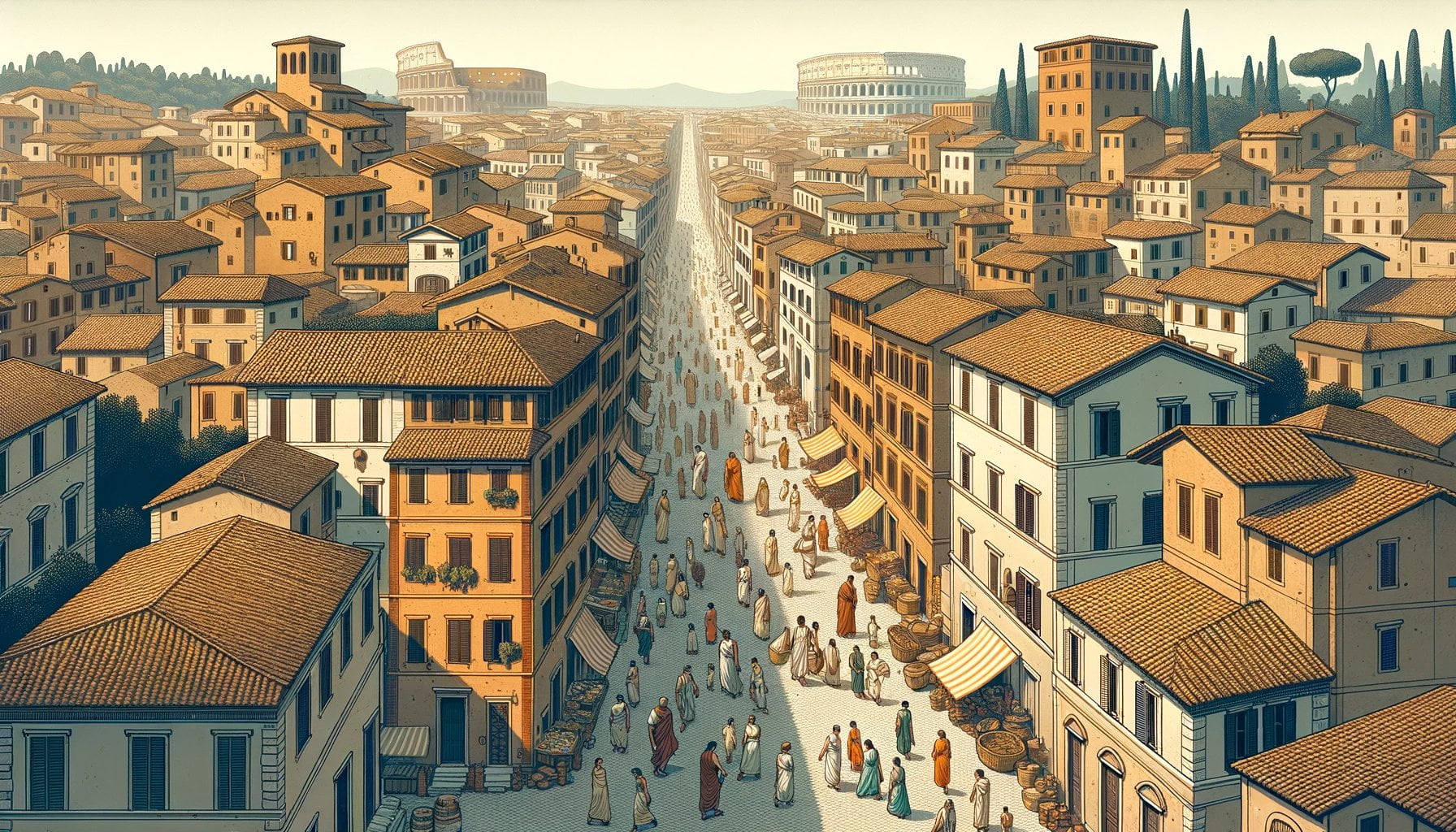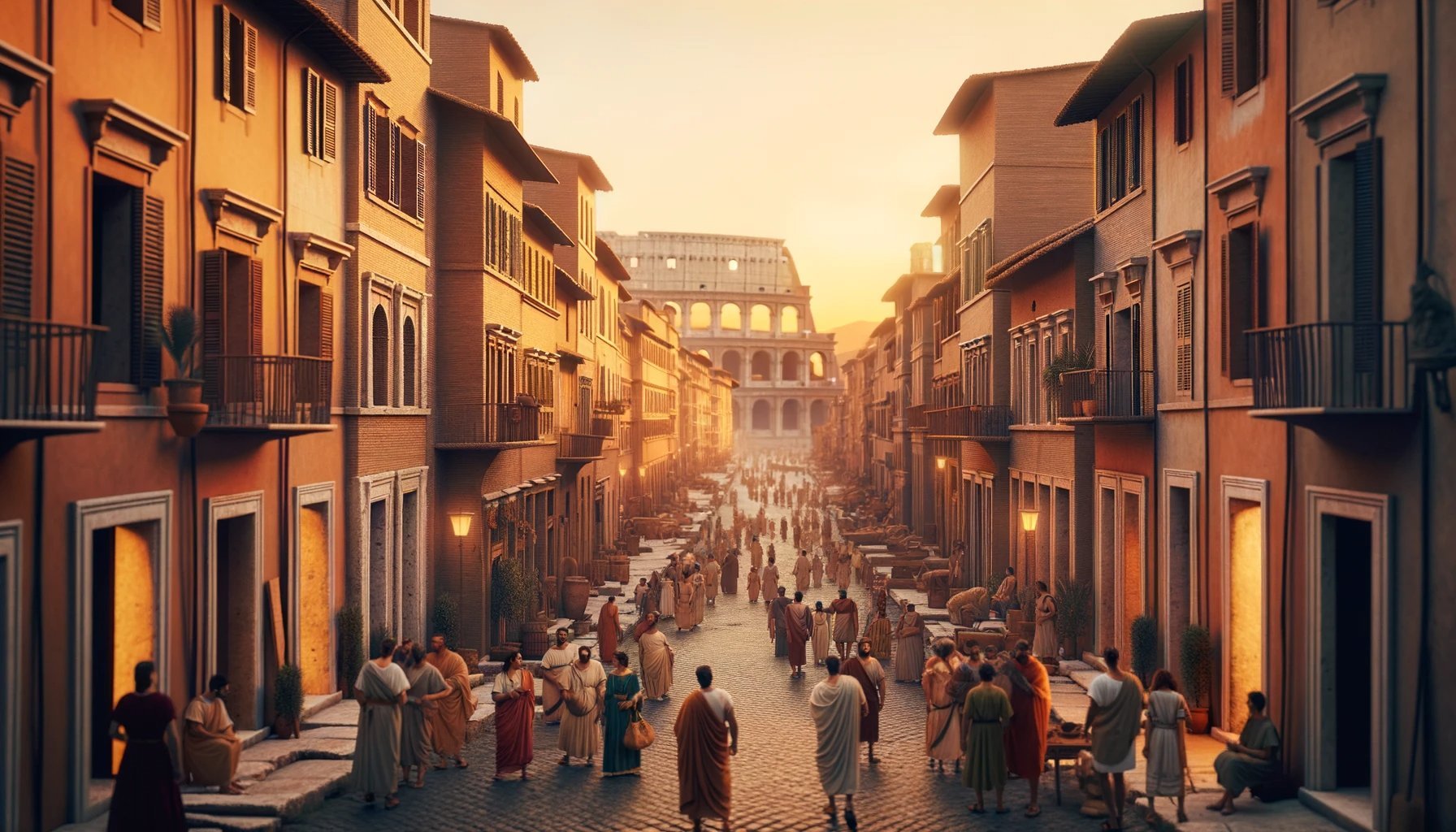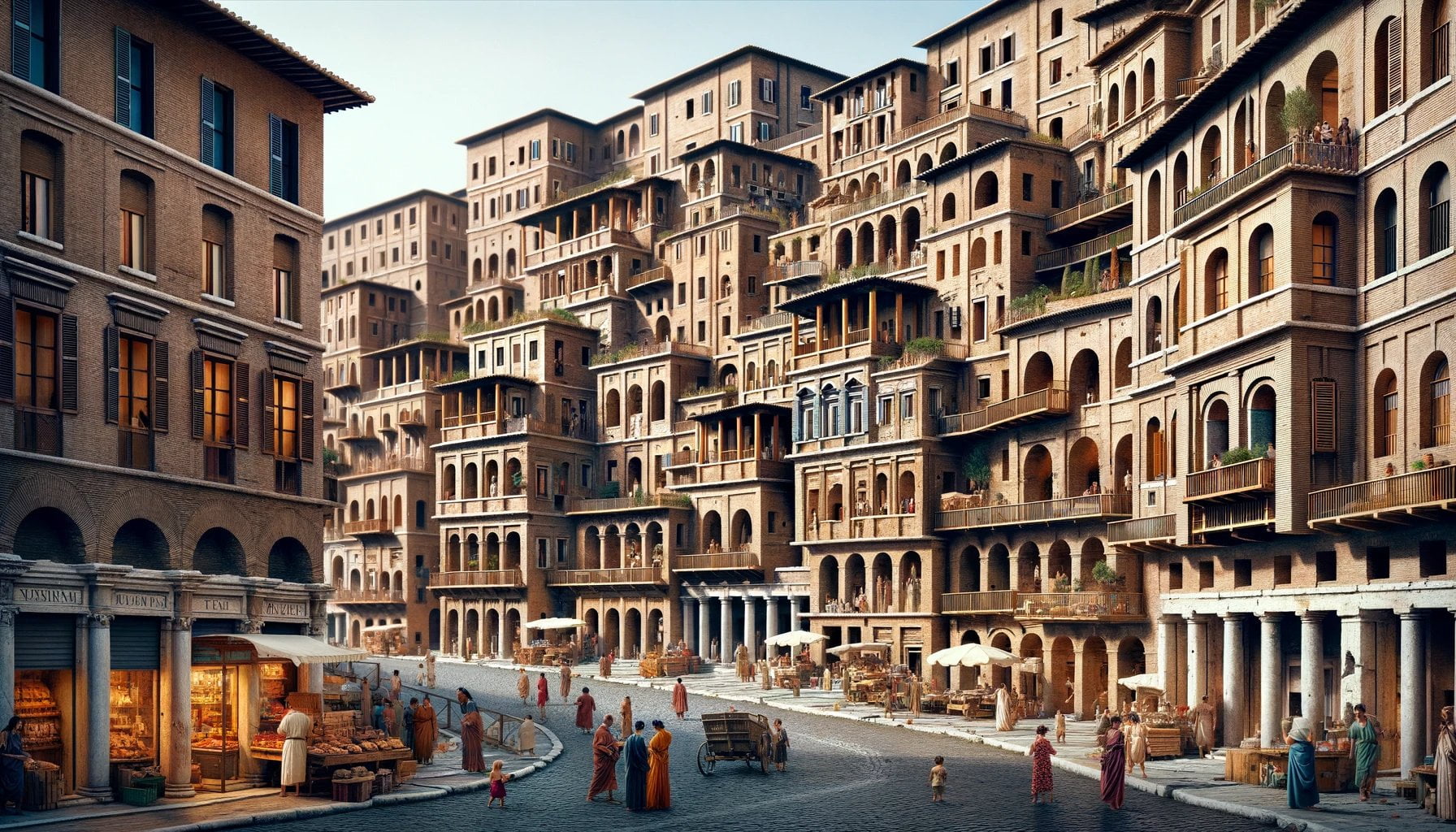In the fascinating realm of ancient Rome, few structures are as captivating as the insulae. These towering residential buildings, with their rich architectural design and intricate historical significance, offer a window into the vibrant urban landscape of the past. As a seasoned archaeologist and historian specializing in ancient Rome, my in-depth knowledge and expertise allow me to unravel the mysteries surrounding these remarkable structures. Through meticulous research and comprehensive documentation, I aim to shed light on the insulae’s cultural and socioeconomic importance, bridging the gap between history and the present.
Key Takeaways:
- Insulae in ancient Rome were either apartment buildings or city blocks made of timber, brick, and later Roman concrete.
- They were prone to fire and collapse, leading to the implementation of height limits by Augustus, Nero, and Trajan.
- Marcus Licinius Crassus owned numerous insulae in Rome and profited from them.
- Living quarters in insulae were smallest on the upper floors and largest on the bottom floors.
- Insulae could reach up to nine storeys before height restrictions were enforced.
- The only surviving insula in Rome is the five-storey Insula dell’Ara Coeli.
- Insulae at Ostia Antica provide insights into luxurious living arrangements with kitchens, latrines, and piped water.
- Augustus, Nero, and Trajan implemented reforms to increase building safety and restrict insulae height.
- Height limits were initially set at 70 Roman feet by Augustus and later reduced to 60 Roman feet by Trajan.
- The exact number of insulae in Rome remains uncertain, but there were approximately 44,000 recorded in the 4th-century Regionary catalogues.
Insulae in Ancient Rome: Unveiling the City’s Unique Residential Structures

Ancient Rome stands as a testament to the ingenuity and complexity of a civilization long gone. And within its bustling urban landscape, the insulae, or apartment buildings, exude a unique allure that captivates historians, archaeologists, and curious minds alike. In this article, we will embark on a journey through time to uncover the architectural marvels and the rich historical significance of insulae in ancient Rome.
Understanding Insulae: Bridges to the Past
The term “insula” originally referred to a city block in Roman architecture, but it eventually became closely associated with multi-story apartment buildings. Insulae were seen as symbols of urban living, providing shelter to the diverse population of ancient Rome. These towering structures, constructed primarily with timber, brick, and later Roman concrete, were both a beacon of the city’s prosperity and a reflection of its challenges.
The Rise and Fall: Architectural Features and Challenges
Insulae in ancient Rome rose rapidly, reaching staggering heights of up to nine storeys. However, their lofty grandeur came at a price. The extensive use of flammable materials and the absence of stringent safety measures made them highly susceptible to fire and collapse. These architectural flaws, combined with the overcrowded and cramped living conditions, created a constant air of fragility within the insulae.
Living in Vertical Communities: Socioeconomic Dynamics
Step inside the insulae, and you will witness a microcosm of Roman society. From humble dwellings to opulent apartments, the living quarters within these structures varied greatly based on social status. The lower floors boasted spacious apartments that catered to the affluent residents, while the uppermost floors housed the less fortunate in cramped and dilapidated rooms. It was a stark reminder of the socioeconomic disparities prevalent in ancient Rome.
A Glimpse Inside: Insights from Ostia Antica
Although the majority of insulae in ancient Rome have been lost to time, the archaeological site of Ostia Antica offers a remarkable glimpse into the opulent side of these residential structures. Here, we find evidence of luxurious living arrangements, complete with kitchens, latrines, and even piped water—a testament to the advanced urban planning and infrastructure of the ancient city.
Reforms and Resilience: The Changing Landscape of Insulae
In response to ongoing concerns about safety, several emperors, including Augustus, Nero, and Trajan, implemented regulations to increase the stability and reduce the height of insulae. Augustus initially set the height limit at 70 Roman feet, which was later reduced to 60 Roman feet by Emperor Trajan. These reforms aimed to safeguard the lives and well-being of the inhabitants, marking a pivotal point in the evolution of Roman urban planning.
Legacy and Preservation: The Last Standing Insula
As the passage of time continues to erode the remnants of ancient Rome, only one insula has managed to withstand the test of time—Insula dell’Ara Coeli. This five-story structure, located in Rome, serves as a physical testament to the architectural wonders that once graced the city. Its preservation not only provides a glimpse into the past but also serves as a constant reminder of the ancient Roman way of life.
Unraveling the Mystery: Insulae in Modern Context
The insulae of ancient Rome may have faded into history, but their legacy lives on, woven into the very fabric of our modern society. Uncovering the mysteries and understanding the captivating story behind these residential structures offers a window into the past, bridging the gap between ancient Rome and our present.
As we delve deeper into the world of insulae, we begin to comprehend their impact on urban development, socioeconomic dynamics, and the architectural innovations they inspired. The insulae of ancient Rome stand as a testament to human resilience, creativity, and the eternal quest for progress—a reminder that the past holds invaluable lessons for the present and future.
| Insulae in Ancient Rome: Key Features | |
|---|---|
| Construction materials | Timber, brick, and later Roman concrete |
| Maximum height before reforms | Nine storeys |
| Socioeconomic dynamics | Varied living quarters; wealth disparity |
| Notable surviving insula | Insula dell’Ara Coeli (five-storey structure) |
| Safety reforms | Introduced by Augustus, Nero, and Trajan |
[Subheading: Rediscovering Insulae: Insights from Ostia Antica]
[Subheading: Unveiling the Legacy: Insula dell’Ara Coeli]
[Subheading: Modern Perspective: Lessons from the Past]
In ancient Rome, there were many important people who played significant roles in shaping the empire. If you’re curious to learn more about these influential figures, click here to explore our list of important people in ancient Rome: important people in ancient rome.
Did you know that the origins of ancient Rome have black origins? Discover the fascinating history of the black origins of ancient Rome by clicking here: black origins of ancient rome.
Are you interested in ancient weapons? Experience the power and craftsmanship of an ancient Rome dagger by clicking here: ancient rome dagger.
Step into the world of ancient Rome and witness the array of weapons that warriors used in battle. Click here to explore the diverse arsenal of ancient Rome weapons: ancient rome weapons.
Socioeconomic Significance of Insulae
Key Takeaways:
– Insulae were multi-story apartment buildings in ancient Rome that served as crucial housing for the urban population, particularly the lower and middle classes.
– These buildings, with their architectural features and cramped living conditions, played a significant role in shaping the social and economic landscape of ancient Rome.
– Insulae were constructed quickly and often made of cheap materials, which made them prone to fire and collapse, posing safety risks for residents.
– There were socioeconomic disparities within insulae, with wealthier residents occupying lower floors while less fortunate residents lived on upper levels.
– Insulae were a symbol of urban living and highlighted the stark contrasts between different segments of Roman society.
The Socioeconomic Impact of Insulae on Ancient Rome
In ancient Rome, the insulae were more than just buildings; they were miniature cities within the city. These multi-story apartment complexes rose high above the city streets, providing housing for the bustling urban populace. However, their significance extended far beyond serving as mere shelter. Insulae were instrumental in shaping the socioeconomic dynamics of ancient Rome.
The term “insula” derives from the Latin word for “island,” and these structures did, indeed, resemble islands rising from the urban landscape. [Socioeconomic Significance of Insulae] They were home to a diverse range of Romans, including merchants, laborers, artisans, and freed slaves. The insulae offered affordable housing options, which predominantly attracted the lower and middle classes.
The Architectural Features and Challenges
The architectural features of the insulae were intriguing yet presented numerous challenges. These buildings had multiple stories, some soaring up to nine floors high. Constructed rapidly and often with haphazard planning, the ground levels were typically made of brick, while the upper stories were composed of cheaper materials like wood. This construction method made the insulae susceptible to both fire and collapse, posing significant safety risks for the residents.
Socioeconomic Disparities Within Insulae
Within the insulae, clear socioeconomic disparities existed. Wealthier and more socially prominent individuals typically occupied the lower floors, enjoying more spacious and comfortable apartments. In contrast, the less fortunate members of society lived on the higher levels, enduring tighter living quarters, and often limited access to natural light and ventilation. The vertically arranged apartments within the insulae reflected the hierarchical structure of Roman society.
The Symbol of Urban Living
Insulae were a defining symbol of urban life in ancient Rome. They represented the rapid growth and development of the city, as well as the challenges that came with it. The insulae served as a stark visual reminder of the stark socioeconomic contrasts within Roman society. Rows of these towering structures created an architectural tapestry that highlighted the disparities between the wealthy elite and the majority of the population.
In conclusion, the socioeconomic significance of insulae in ancient Rome cannot be overstated. These architectural marvels were a reflection of the urban landscape, transforming the cityscape and providing crucial housing for the lower and middle classes. However, they also underscored the sharp economic divisions within Roman society. The survival of insulae remains a testament to the importance of understanding and preserving the past to gain insights into the present.
Sources:
– Encyclopedia Britannica: Insula
– Khan Academy: Roman domestic architecture (insula)
Role of Insulae in Urban Development
[Role of Insulae in Urban Development] in Ancient Rome played a crucial role in shaping the city’s landscape and meeting the housing needs of its growing population. These multi-story apartment buildings provided homes for the majority of the urban populace, especially the lower- and middle-class residents. Let’s delve into the significance of insulae and their impact on ancient Roman urban development.
What Were Insulae?
In the bustling city of Ancient Rome, insulae symbolized urban living, rising quickly to tall heights. These structures, also known as Roman commoner houses, were compact to efficiently utilize limited space and resources. The term “insula” means “island” in Latin, reflecting their appearance as towering apartment buildings that stood above the city landscape. With their architectural design and multiple stories, they housed multiple families and served as both residential and commercial spaces.
The Urbanization Boom
During the Roman Republic and Empire, Rome experienced rapid urbanization. As the city’s population grew, insulae emerged as a practical and cost-effective solution to the housing needs of the expanding urban population. They were constructed quickly and often made of inexpensive materials, resulting in their susceptibility to fire and collapse. Despite these risks, insulae flourished due to their ability to accommodate the growing masses.
Socioeconomic Disparities and Safety Concerns
The residents of insulae were diverse, with affluent individuals occupying the lower floors and less fortunate individuals residing on the upper levels. This socioeconomic divide within insulae emphasized the contrasts between the different segments of Roman society. Emperors recognized the safety risks associated with these towering structures and implemented regulations to increase stability and reduce building height. However, the dangers of fire and poor living conditions persisted, putting the residents at risk.
Insights from Archaeological Sites
Archaeological sites, such as the Capitoline Insula and Ostia Antica, provide valuable insights into the daily lives and social systems of ancient Roman society within insulae. These sites offer glimpses into the luxurious living arrangements within insulae, showcasing the intricate architecture and living spaces of the past. The remaining insula dell’Ara Coeli is a testament to Roman architecture, serving as a physical reminder of their existence.
Impact on Urban Development
Insulae played a significant role in establishing the social and economic landscape of Roman urbanism. They provided housing for the majority of the urban population, contributing to the growth and development of ancient Roman cities. The legacy of insulae can be seen in their impact on urban development, socioeconomic dynamics, and architectural innovations. By studying insulae, we gain valuable lessons from the past that can inform present and future urban planning endeavors.
Key Takeaways:
- Insulae were multi-story apartment buildings in Ancient Rome that symbolized urban living and sheltered the diverse population.
- Insulae rose quickly to tall heights but were susceptible to fire and collapse due to flammable materials and lack of safety measures.
- Socioeconomic disparities were prevalent in insulae, with affluent residents on lower floors and less fortunate residents on upper floors.
- Archaeological sites like the Capitoline Insula and Ostia Antica provide insights into the luxurious living arrangements within insulae.
- Emperors implemented regulations to increase stability and reduce height in response to safety concerns.
- Insula dell’Ara Coeli is the only remaining insula in Ancient Rome and serves as a physical testament to Roman architecture.
- The legacy of insulae in ancient Rome is seen in their impact on urban development, socioeconomic dynamics, and architectural innovations.
- Insulae provide valuable lessons from the past for the present and future.
Sources:
1. Roman Living for the Masses: A Glimpse into Insulae Life – LinkedIn
2. Ancient Roman Insula – Ancient-Rome.info
Decline and Legacy of Insulae in Ancient Rome
Insulae, the high-rise apartment buildings of ancient Rome, played a vital role in shaping the city’s urban landscape and accommodating its growing population. However, despite their significance, these architectural marvels experienced a decline that left a lasting legacy. In this article, we will explore the decline and legacy of insulae in ancient Rome, shedding light on their architectural features, socioeconomic dynamics, and impact on urban development.
The Decline of Insulae: A Closer Look
As the urban population grew in ancient Rome, the demand for housing escalated, leading to the construction of insulae. These multi-story apartment buildings provided shelter for the majority of the population, particularly those of lower- or middle-class status. However, the rapid construction and the use of cheap materials made insulae susceptible to collapse and fire hazards, posing significant safety risks for the residents.
The decline of insulae began as a result of these safety concerns. Emperors implemented regulations to increase stability and minimize the risk of collapse and fire incidents. Height restrictions were enforced, limiting the number of floors and emphasizing safety measures in their construction. Despite these efforts, the decline of insulae continued as maintenance and upkeep became challenging, resulting in neglect and deteriorating conditions.
Legacy of Insulae: Traces of Ancient Urban Living
Despite their decline, insulae left a lasting legacy that continues to shape our understanding of ancient Roman society and urban development. These towering residential structures remain a symbol of urban living and highlight the stark socioeconomic disparities that were prevalent in ancient Rome. Wealthier residents occupied lower floors, while the less fortunate found themselves on the upper levels, enduring cramped living conditions and limited access to basic amenities.
Archaeological sites, such as the well-preserved insulae in Ostia Antica, provide valuable insights into the daily lives and social systems of ancient Roman society. Through these remnants, we gain a glimpse into the luxurious living arrangements within insulae and the complex dynamics that governed them.
Key Takeaways:
- Insulae were multi-story apartment buildings that provided housing for the urban population, particularly the lower and middle classes.
- Rapid construction and the use of cheap materials made insulae susceptible to collapse and fire hazards, leading to safety concerns.
- Emperors implemented regulations to increase stability and minimize risks, such as enforcing height restrictions and safety measures.
- Despite the decline, insulae serve as a physical testament to Roman architecture and the socioeconomic dynamics of ancient Rome.
- Archaeological sites, such as Ostia Antica, provide valuable insights into the daily lives and social systems of ancient Roman society within insulae.
The Architectural Marvels Lost to Time
Today, only the Insula dell’Ara Coeli stands as a surviving monument to ancient Roman insulae. This isolated structure offers a glimpse into the architectural innovations and urban planning strategies employed in ancient Rome. However, the vast majority of insulae have been lost to time, leaving behind fragmented histories that must be pieced together through meticulous research and archaeological excavation.
The architectural legacy of insulae can still be seen in the transition from low-rise to high-rise residential buildings in subsequent eras. Despite their shortcomings, insulae paved the way for more sophisticated urban planning and construction methods, influencing future generations of architects and city planners.
Final Thoughts: Connecting the Past and Present
As we delve into the decline and legacy of insulae in ancient Rome, we uncover a complex tapestry of urban living, socioeconomic disparities, and architectural advancements. Insulae embody the struggle between pragmatism and safety, serving as lessons from the past for present and future urban planning. By understanding their rise and fall, we gain a deeper appreciation for the intricate relationship between architecture, society, and the ever-evolving urban landscape.
Sources:
- Insula | Roman, Apartment & Insulae | Britannica
- Roman domestic architecture (insula) (article) | Khan Academy

FAQ
Q1: What is an insula in ancient Roman architecture?
A1: In ancient Roman architecture, an insula refers to either a type of apartment building or a city block. These structures provided housing for the urban population, especially the lower or middle class.
Q2: How were insulae constructed?
A2: Insulae were often haphazardly constructed, with lower levels made of brick and higher stories made of cheaper materials like wood. Some insulae could reach up to nine floors in height.
Q3: What was the significance of insulae in ancient Rome?
A3: Insulae played a significant role in establishing the social and economic landscape of Roman urbanism. They were a common form of housing and provided accommodation for the majority of the urban populace.
Q4: Who owned insulae in ancient Rome?
A4: Wealthy individuals like Marcus Licinius Crassus owned numerous insulae in Rome and profited from renting them out to tenants.
Q5: What were the risks and challenges associated with living in insulae?
A5: Living in insulae had its dangers, such as the risk of fire and poor living conditions. These structures were prone to collapse and were not always built to high safety standards.
















